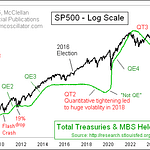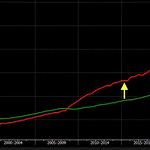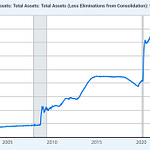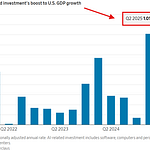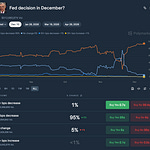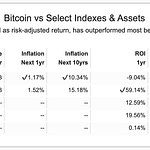This installment of The Pomp Letter is free for everyone. I send this email to our investors daily. If you would also like to receive it every morning, join the 50,000 other investors today.
To investors,
The lifecycle of technology companies has historically looked something like this: start the company, raise venture capital, launch a product, find product-market fit, raise more venture capital, scale the business, raise more venture capital, and eventually take the company public in the equity markets.
This process has historically created immense value, including many of the world’s most valuable companies today. There are two trends that are accelerating that highlight the process can be significantly improved though. The first relates to the length of time companies stay in the private markets and the second has to do with how the traditional IPO pricing mechanism works.

Private Market Returns Dominate
According to CNBC, “On average, the age of companies going public over the past quarter century has stayed roughly the same at eight years -- except when it comes to technology companies. The average tech company age in a public debut rose from three years in 2001 to 13 years in 2018.” One way to think about this is that the longer a company stays private, the less potential return available to public market investors.
It doesn’t mean that no return is available, but it does mean an increasing amount of the returns are going to venture capitalist and accredited investors. Take Amazon as an extreme example. The company was founded July 5, 1994 and went public on May 15, 1997. Amazon’s time in the private markets aligns almost perfectly to the previous three year average. The stock was priced at $18 per share when they entered the public market and today it trades for $2,890 a share. There were also three stock splits before the year 2000, so a public market investor who held since IPO day would have returned over 200,000% in the last two decades.
But what happened in the private markets before Amazon went public?
Jeff Bezos raised just under $1 million of angel investment from 20 - 23 individuals at approximately a $5 million valuation to get the company started. A year or so later, Bezos raised $8 million in 1996 at a $60 million valuation from Kleiner Perkins. Amazon had a market cap of $438 million when it went public in 1997.
Without dilution, the angel investors would have made about 87 times their money and Kleiner Perkins would be up a little more than 7x. These numbers aren’t exact, but it gives you a general idea of the private market return for investors. Compared to the 3,287x increase in the company’s market cap since it has been public, it is easy to see that majority of the value creation has been captured by public market investors.
This trend has changed drastically over the years. A plethora of capital has flooded the private markets, so founders have the ability to stay private longer. The longer they stay private, the more value creation can be captured by private market investors. Use the following companies as examples:
SpaceX has been private for 18 years
Palantir has been private for 17 years
AirBnB has been private for 12 years
Slack was private for 11 years
Uber was private for 10 years
The increased access to capital and lack of scrutiny/reporting required in the private markets makes it attractive to stay private longer for many founders. These same companies lose many advantages as well though, including accurate price discovery, liquidity for employee equity, and tradable shares that can be used as a currency for acquisitions and future hires.
My guess is that we are going to see a reversal of this trend in the coming years. Founders will start thinking that it is cool again to get into the public markets sooner rather than later. The average time in the private markets won’t drop back down to 3 years, but I could see it retreating to around 8 years.
This brings us to the second trend that highlights an area for improvement.
IPO Pricing Is Broken
The traditional process for pricing an IPO has increasingly swung financially in favor of investment bankers and their clients. The overgeneralized version of the process is that companies declare that they plan to go public, they select an investment banking team to work with, the bankers set up a road show full of presentations from management, an IPO price is set, and the company eventually enters the public equity markets at the pre-determined price per share.
The problem with this process is that companies are incentivized to sell shares to investment bankers, their clients, and public market investors at the highest price possible, yet non-company investors are incentivized to buy the shares at the lowest price possible. This difference of incentives theoretically should help to find market equilibrium. In practice, it doesn’t.
Remember, the investment bankers have much more experience than founders in this process. It is literally the job of investment bankers to price IPOs and raise capital as companies enter the public markets. They do this numerous times a month or year. Founders are likely to bring a company public only once in their life, while also having to divert majority of their attention to running their business. It would be an understatement to say that founders and their companies are at a disadvantage in the IPO pricing process.
This lack of balance in power leads to IPOs being priced artificially low, so investors can capture incredible upside return on their investments in a short period of time. This “IPO pop” has somehow become a barometer for how successful an IPO is. Unfortunately, the company is the loser in this trade. Let’s use two recent IPOs as examples — Lemonade and Agora.
Ari Levy of CNBC nailed it when he wrote:
“For a second straight week, a tech company has more than doubled in value upon its stock market debut. Last week, it was Chinese cloud software developer Agora, which surged 150% in its first day of trading on the Nasdaq. And on Thursday, insurance-tech company Lemonade jumped 139%.
Tech IPOs have long been criticized for a process that lets investment bankers hand over underpriced stock to large public money managers, who often enjoy immediate and massive pops before ordinary investors are able to participate. Meanwhile, the issuing company ends up raising far less money than it could.
Over the past four months, with face-to-face meetings off the table, IPO roadshows have gone virtual. Management teams, with the help of bankers, are selling their story over Zoom rather than spending two weeks traveling to the money hubs of New York, Boston, Baltimore and San Francisco.
While they may be saving money on travel, they’re still leaving piles of cash on the table. Lemonade sold 11 million shares at $29 a piece, bringing in just over $300 million and giving new investors the $444 million difference, based on the closing price of $69.41. That’s a big deal for a company that had cash and cash equivalents of about $567 million before the IPO.”
In each of these scenarios, investment bankers and their clients more than doubled their money in a matter of minutes, yet the companies left hundreds of millions of dollars on the table. Seems like a one-sided trade, right? That is because it is. The success of an IPO should not be determined by how much the stock price appreciates once it is liquid, but rather by how much capital a business can raise without seeing a substantial drop in share price once the stock is trading.
Bill Gurley of Benchmark has been arguing this concept for awhile now.
So what exactly is the answer to the IPO pricing problem?
The simple answer is to conduct direct listings, which both Spotify and Slack have done. These direct listings circumvent the IPO process and allow existing shareholders to sell their shares directly to the public at market clearing prices. The goal is to have better price discovery. It should also allow the company to raise more capital for future business endeavors.
The longer answer is that many companies can actually mitigate the pricing issues by going public sooner or by leveraging reverse takeovers. The earlier a company goes public, the less aggregate dollars they miss out on if there is a pricing issue. Mis-pricing the IPO by 25% for a $400 million company is $100 million vs mis-pricing the IPO by 25% for a $1 billion company is a loss of $250 million for the company.
The reverse takeovers allow a shell company or blank check company to acquire an existing attractive business. The final result is that the private market company is now publicly traded post-merger with the publicly traded smaller organization. We recently saw Chamath Palihapitiya do this with Virgin Galactic and it was quite successful.
In each scenario, we are likely to see a convergence of the reversal of both trends. Companies will start going public sooner and they will avoid the traditional IPO process. Founders will pursue direct listings if they are larger and small-to-medium sized businesses will pursue reverse takeovers.
The public markets have long been avoided by tech company founders. Those days are numbered though. There are definitely challenges with operating a publicly traded company, but the benefits drastically outweigh the downside.
-Pomp
This installment of The Pomp Letter is free for everyone. I send this email to our investors daily. If you would also like to receive it every morning, join the 50,000 other investors today.
Disrupt Everything. For hundreds of years, 276 to be exact, if you wanted to invest in art you had to attend an insiders-only art auction (paddle in hand). But just like the steam engine or printing press, the advent of modern investing platforms like Masterworks are likely to disrupt the industry forever. You do the math: over $2 trillion of wealth is held in art and only one company can get you in on the ground floor. Don’t want to wait? I’ve partnered with Masterworks so you can skip the 25,000 waitlist here.*
*See Disclaimer
THE RUNDOWN:
Bitcoin Miners Saw 23% Revenue Drop in June: Bitcoin miners suffered a 23% drop in revenue during June, resulting from lower network fees and a reduced block subsidy after the halving in May. Down from $366 million in May, bitcoin miners generated an estimated $281 million in revenue in June, a three-month low according to Coin Metrics data analyzed by CoinDesk. Estimates assume miners sell bitcoins immediately. Read more.
Bitcoin Startup Zap Is Working With Visa: Lightning developer and Zap, Inc. founder Jack Mallers announced Thursday his startup’s Strike product, which allows people to receive bitcoin as dollars via direct bank deposits, is finally entering public beta. A Visa card is also in the works. Read more.
New York-Based Asset Manager Closes $190M Round for Bitcoin Institutional Fund: The New York Digital Investment Group has raised $190 million for one of its bitcoin funds, according to a Form D document submitted to the U.S. Securities and Exchange Commission on Wednesday. Read more.
Intel to Invest in Jio Platforms, After Facebook’s $5.7B Bet on the Indian Telco: Intel is investing over $250 million in Indian telco Jio Platforms, just three months after Facebook announced a $5.7 billion bet on the company. Owned by billionaire Mukesh Ambani’s Reliance Industries, Jio Platforms announced the Intel investment in a media release on Friday via Twitter. Intel will inject $253.5 million into the company, which is valued at $65 billion, in exchange for 0.39% stake. Read more.
TuSimple Plans Autonomous Truck Network Backed by UPS: Ahead of the commercial rollout of its driverless trucks by 2024, TuSimple today outlined the launch of what it’s calling the world’s first autonomous freight network. In partnership with UPS, Penske, U.S. Xpress, and McLane Company, TuSimple plans to establish an “ecosystem” of autonomous trucks, complemented by digitally mapped routes, strategically placed terminals, and a monitoring system dubbed TuSimple Connect. Read more.

LISTEN TO THIS EPISODE OF THE POMP PODCAST HERE
Today’s episode was a special “thank you” to every listener. I asked for questions on Twitter and received a few hundred of them. Last night I sat down with Polina and tried to answer as many of them as possible. The topics range from finance to startups to technology to my personal life.
I really enjoyed recording this episode. Hopefully you enjoy it too.
LISTEN TO THIS EPISODE OF THE POMP PODCAST HERE
We have started a new show exclusive to YouTube called Lunch Money. The goal is to cover current events in business, finance, and technology from the perspective of the every day citizen, rather than the talking heads on television. It is just as funny and entertaining as it is educational. Hope you enjoy it and make sure you go subscribe to the YouTube channel!
Podcast Sponsors
These companies make the podcast possible, so go check them out and thank them for their support!
Choice is a new self-directed IRA product that allows you to buy Bitcoin with tax-advantaged dollars, while still holding your private keys. You can go to retirewithchoice.com/pomp to sign up today.
Helium Hotspots allow you to earn cryptocurrency by building a new wireless network for the Internet of Things and creating a more connected future in your city. Get $50 off your Helium Hotspot by going to helium.com and using my special code POMP at checkout.
Unstoppable Domains is working to make the internet operate how it was originally intended, which means anyone can publish anything from anywhere. You can go to unstoppabledomains.com and claim your censorship resistant domain today.
BlockFi allows you to keep your crypto, put it up as collateral, and receive a USD loan funded directly to your bank account. They do loans ranging from $2,000 to $10,000,000, and they're perfect for helping you reach your financial goals of all sizes. Visit BlockFi.com/Pomp to learn more about putting your crypto to work without having to sell it by getting a loan or earning interest in their interest bearing accounts.
Crypto.com allows you to buy, sell, store, earn, loan, and invest various cryptocurrencies in an user friendly mobile app. Join over one million users today. You can download and earn $50 USD with my code “pomp2020” when you sign up for one of their metal cards today.
Blockset by BRD is your hosted blockchain infrastructure. Blockset enables enterprises and developers around the globe to deliver high-quality blockchain-based applications in a fraction of the time, at a fraction of the cost.
If you enjoy reading “The Pomp Letter,” click here to tweet to tell others about it.
Nothing in this email is intended to serve as financial advice. Do your own research.





